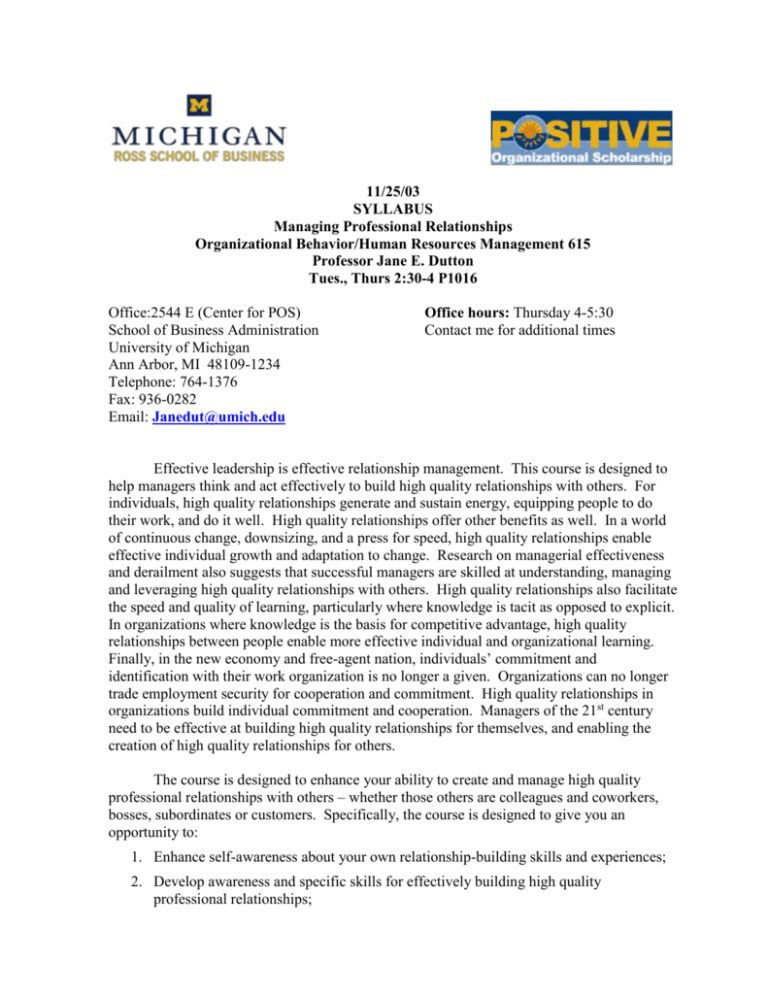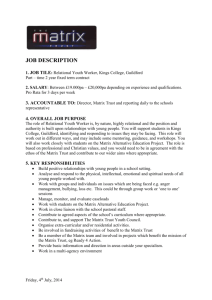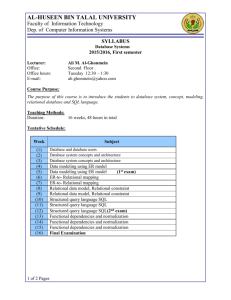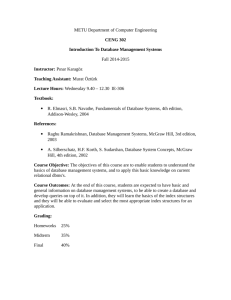Course Syllabus - Center for Positive Organizations
advertisement

11/25/03 SYLLABUS Managing Professional Relationships Organizational Behavior/Human Resources Management 615 Professor Jane E. Dutton Tues., Thurs 2:30-4 P1016 Office:2544 E (Center for POS) School of Business Administration University of Michigan Ann Arbor, MI 48109-1234 Telephone: 764-1376 Fax: 936-0282 Email: Janedut@umich.edu Office hours: Thursday 4-5:30 Contact me for additional times Effective leadership is effective relationship management. This course is designed to help managers think and act effectively to build high quality relationships with others. For individuals, high quality relationships generate and sustain energy, equipping people to do their work, and do it well. High quality relationships offer other benefits as well. In a world of continuous change, downsizing, and a press for speed, high quality relationships enable effective individual growth and adaptation to change. Research on managerial effectiveness and derailment also suggests that successful managers are skilled at understanding, managing and leveraging high quality relationships with others. High quality relationships also facilitate the speed and quality of learning, particularly where knowledge is tacit as opposed to explicit. In organizations where knowledge is the basis for competitive advantage, high quality relationships between people enable more effective individual and organizational learning. Finally, in the new economy and free-agent nation, individuals’ commitment and identification with their work organization is no longer a given. Organizations can no longer trade employment security for cooperation and commitment. High quality relationships in organizations build individual commitment and cooperation. Managers of the 21st century need to be effective at building high quality relationships for themselves, and enabling the creation of high quality relationships for others. The course is designed to enhance your ability to create and manage high quality professional relationships with others – whether those others are colleagues and coworkers, bosses, subordinates or customers. Specifically, the course is designed to give you an opportunity to: 1. Enhance self-awareness about your own relationship-building skills and experiences; 2. Develop awareness and specific skills for effectively building high quality professional relationships; 3. Develop awareness and skills for minimizing damage from low quality, corrosive professional relationships. 4. Build a logic for building and managing organizations with relational capability as an organizational strength We begin the course by building the business case for why understanding the management of professional relationships is so critical for individuals and for firms. The first portion of the course focuses on four foundation skills for building high quality relationships. The second portion focuses on challenges to building effective relationships. The third section of the course focuses on deriving a framework for building relational capability. The course wraps up with a more reflective session on how you aspire to add relational value as a manager. Required text: Jane E. Dutton, 2003 Energize your workplace: How to create and sustain high quality relationships at work, San Francisco: Jossey-Bass A course pack of readings is available through the Course Pack Office. Additional handouts will be distributed in class. You must complete the listed readings and assignments prior to the class in which they are listed. Assignments: There are five products that compose your grade: a learning log, case write, letter of contribution, and class participation (individual products) and Relational Capability Analysis (pair project). As is the case with all 7-week classes, we are under a tight time frame and as a result none of the assignments will be accepted late. Learning logs: These logs provide you with an opportunity to reflect on the ways in which the issues and concepts raised in class affect you personally and your role as a manager. The questions to be answered in these logs are attached to the syllabus. You will have the option to select one of the five sets of questions to reflect on and write about. The question sets described are at the end of the syllabus. You also have an option to hand them in on two different dates (Jan. 16 or Jan. 30). You must answer one of the sets during the course of the term and had it in on the appropriate date Case write-up: The case write up is due at the beginning of the class on February 3. In no more than 5 typed spaced pages 1. Identify important actions that Reuters took in response to the 9/11 trauma. In doing so, make sure that you choose the actions that you believe were most pivotal. 2. What made it possible for Reuters to take the actions you identified in Q1? 3. What was the role of leadership in explaining the pattern of response? Exemplar of Relational Capability Pair up with one other person. Identify an organization (or unit within an organization) that you believe excels in relational capability. Develop a relational capability scorecard for evaluating the organization (or unit). Make your case based on available first hand or second hand data about how the organizations scores in terms of 2 relational capability. Draw conclusions about the relational capability of your focus organization. Prepare your analysis on PowerPoint and mount it on a poster. On Feb. 10 we will set up Poster Displays in Phelps Lounge) and will cruise the room (with food and drink) to learn from others’ analyses about different forms of relational capability. Submit your PowerPoint slides to me as your product at the end of the class. Grading of this assignment is based on how the soundness of your analysis and the clarity of your presentation. Letter of contribution: The purpose of this assignment is a different form of reflection and goal setting. (handout will follow) Due on Feb. 17. Evaluation Final grades will be determined by the following components and weighting: Self-reflection in learning logs: 1 from Set 1 20 points Or Set 2 Reuters case write-up 20 points Exemplar of relational capability 20 points Letter of contribution 20 points Class Participation 20 points Total 100 points Grading: I will follow the University of Michigan Business School Policy regarding the grading curve. The policy states that no more that 25% of the students will receive an excellent, approximately 70% will receive a grade of good or pass and approximately 5% will receive a low pass if the student’s performance merits it. This policy applies primarily to core courses and this is an elective course, so I have some flexibility in assigning grades depending on student performance. Class 1 Tue., Jan. 6 The relationship imperative: Why is managing relationships important from an individual, organizational and societal perspective? Required readings Dutton, Energize Your Workplace, Chapter 1. “Relationships: The new bottom line in business” Chapter 1 from Lewin and Regine, 2002 (1-28). (Coursepack) I. Building relationship-management skills Class 2 Th., Jan. 8 Inspiring: Building effective relationships through vision, language and dialogue Required reading 3 Kouzes, James M. and Barry Z. Posner, 1995. “Envision the Future: Imagining Ideal Scenarios.” In The Leadership Challenge. Jossey-Bass Publishers, pp. 91-111. (coursepack) Class 3 Tue., Jan.13 Recognizing, respecting, listening: Building effective relationships through respectful engagement Required readings Hallowell, Edward M., 1999. “The Human Moment at Work.” Harvard Business Review, January-February. (Coursepack) Dutton, J. Energize your workplace Chapter 2. Class 4 Th., Jan. 15 Enabling the success of others: Building relationships through task enabling Dutton, Energize your workplace, Chapter 3. Jackson, P., 1995. Chapter 9: “The invisible leader.” In Sacred Hoops. P. Jackson and H. Delehany (Eds.). New York: Hyperion, pp. 148-168. (coursepack) Learning Log Submission #1: Due Friday, Jan. 16 by 4:30 Class 5 Tue., Jan.20 True blue: Building relationships through trusting others Dutton, Energize your workplace, Chapter 4. Case: Mike Johnson (A) (Coursepack) Handout: Mike Johnson (B) Handout: “The case of temperamental talent” (prepare for next class) 4 II. Mastering Relationship Challenges Class 6 Th., Jan. 22 Dealing with corrosive relationships at work Required Readings Dutton, Energize Your Workplace, Chapter 5. Frost, P. and S. Robinson, 1999. “The Toxic Handler: Organizational Hero – and Casualty.” Harvard Business Review, July-August, pp. 95-106. (coursepack) Prepare case: Rothstein, L. R., 1992. “The case of temperamental talent.” Harvard Business Review (will be handed out previous class). (Come into class having made a decision: Do you keep Ken Vaughn or let him go?) Extra Readings: Alan Webber: “Danger Toxic Company” Fast Company (http://www.fastcompany.com/online/19/toxic.html) Hand out FIRO questionnaire—MUST COMPLETE BY CLASS 9, JAN. 29) Class 7 & 8 Sat., Jan. 24 Jan 27 Simulation: Managing Relationships in the New Economy Special session 8:30-12 (Required – if you cannot attend this, you cannot take the class – you have a choice to be in the simulation either the 24th or the 31st – both Saturdays) No class: recovery from simulation Class 9 Th., Jan.29 Managing power differences: Managing relationships with your boss and managing relationships as boss Required Readings Gabarro, John J. and John P. Kotter, 1993. “Managing Your Boss.” Harvard Business Review, May-June, pp. 150-157. (coursepack) Complete FIRO questionnaire before class Learning Log Submission #2: Due by Friday, Jan. 30 at 4:30 5 III. Building Relational Capability as an Organizational strength Class 10 Tue., Feb. 3 Leadership and the Management of Relationships Required readings Dutton, J. E., J. P. Frost, M. Worline, J. Lilius and J. Kanov, 2002. “Leading in traumatic times.” Harvard Business Review, January. (coursepack) The Heart of Reuters A (coursepack) Handout in class: Part B of Reuters Due: Executive memo: Case analysis of Reuters case due at beginning of class today Class 11 Th. Feb. 5 Designing Organizations with Relational Capability Required Readings: Dutton, Energize your Workplace, Chapter 6. We will have at least 45 minutes in this class to work on the living exemplars for the next class Class 12 Tues. Feb. 10 Excellence in Relational Capability: Living Exemplars Due in class Pair Analysis of Organizations that Excel in Relational Capability CLASS MEETS IN PHELPS LOUNGE IV. Moving Forward with a Relational Mindset Class 13 Thurs. Feb 12 Living Relationally: Being a Contribution Required Reading: Zander and Zander, The Art of Possibility, Chapter 4 Being a contribution (Coursepack) Letter of contribution due at the beginning of this last class Feb. 17 (No class—this is the other day off from the simulation Saturday) 6 LEARNING LOG QUESTIONS: SET 1 Note: Please answer ONE of the two sets of questions if you chose to do a first learning log. Each question set should be answered in no more than 6 pages (double-spaced). I will respond to the logs by evaluating how reflective, complete and well-organized they are. Set 1; Leadership, language and connection Purpose: To analyze the power of language to create or destroy relationships 1. Pick an organization with which you have been or are currently affiliated or desire to be affiliated with (can be a business or non-business organization). Find a speech or text produced by a power broker or leader in the organization, or by some official body. (Hint: you can often find speeches etc. on the web for many organizations. Attach a copy of the text to your log entry.) 2. Do an analysis of the language in the document in terms of what it implies about relationship. What do the words, images, phrases or metaphors used in the text reveal about the relational context of this organization? Explain. 3. Assume you are starting your own organization from scratch. What words, images, phrases and metaphors would you see as most critical for conveying or creating a relational context for your organization? Justify your choices. Set 2: Strategies for building connection through enabling of others Purpose: To reflect upon the effectiveness of different enabling strategies you use with others 1. Fill out Exhibit 3-2 on page 77 in Energize your Workplace (You select the job you want to use for doing this analysis. It can be for any job you have done in the past or are currently doing). 2. Describe what task enabling strategies you use most often and why. 3. What task enabling strategies are most successful for enabling others from your experience? Why are they most effective? 4. Describe what you need to do to improve your task enabling of others. LEARNING LOG QUESTIONS: SET 2 Note: If you chose to answer questions from this second log set, please answer one of the four sets of questions for your learning log. Each question set should be answered in no more than 6 pages (double-spaced). I will respond to the logs by evaluating how reflective, complete and well organized they are. 7 Set 3 To trust or not to trust: That is the question Purpose: To analyze how you build connection through trusting or distrusting others1 1. Think of two people, one that you trust, and one that you don’t trust. 2. List the reasons that lead you to trust or distrust each person (no need to identify the real person -- can use disguised names). 3. What do you do to communicate to each person that you trust or don’t trust them (i.e. what are the behaviors that you are doing that engender trust or distrust)? 4. What, if anything, could the person you distrust do to earn your trust? 5. What do you have to do to enable this to happen? 6. What are the managerial implications of your analysis for turning around distrustful connections? Set 4 Antidotes to toxicity in organizations Purpose: To reflect on how to work with a corrosive connection in the workplace 1. Describe a situation in which you were affected by toxicity from a corrosive connection in a current or former work organization. 2. What were the effects of the toxicity on you and on others? 3. What, if anything could have been done to reduce the effects of the toxicity in this situation? 4. Were there any preventative measures that could have been taken to reduce the damage from the toxicity? Set 5 Building high quality connections Purpose: To proactively consider strategies for building or strengthening he quality of a connections with a significant work colleague. 1. Select a relationship or connection at work that is (or was) important to you. Briefly describe it. 2. How would you characterize the quality of the connection you have with this person? What are its indicators? 3. What are the 2 most important steps you could take to improve the quality of the connection with this person? Why do you think they will work? 4. What are you most concerned about in accomplishing this relational change? 5. How will you accomplish the change in a way that deals with these concerns? 1 (Modified from Paula Caproni’s “Food for thought”, in The Practical Coach 8






